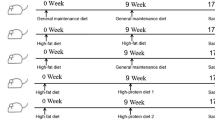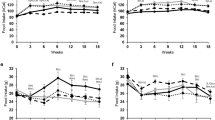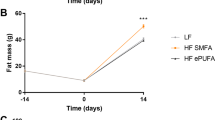Abstract
OBJECTIVE: To determine how the ability of skeletal muscle to manage amino acids is conditioned by obesity. The test was performed in two different models of obese rats: diet-obese rats and genetically obese rats. SUBJECTS: Lean and genetically obese (fa/fa) male Zucker rats were used. DESIGN: For up to 60 d of life lean animals were fed with standard chow pellet or with a hypercaloric cafeteria diet. Genetically obese rats were fed with standard chow pellet during the same period. MEASUREMENTS: Amino acid concentration in the femoral artery and vein and leg blood flow were measured. Free amino acid concentration, protein and nitrogen content and enzyme activities were determined in whole leg muscle. RESULTS: Amino acid availability was increased in diet-obese animals and remained unchanged in the genetically obese group. The genetically obese groups had a lower protein content and unchanged concentration of amino acids in leg muscle. Furthermore, total nitrogen remained unchanged in these animals and they showed an increased activity in alanine aminotransferase and glutamine synthetase. The leg muscle of the diet-obese rats took up several amino acids (Ala, Arg and Val) or released others (mainly Gln and Gly). Conversely, genetically obese rats took up many amino acids and did not release any. CONCLUSIONS: We conclude that in nutritionally obese rats there is an increased availability of amino acids in skeletal muscle. This augmented availability propitiates the increase in the uptake of many amino acids. In genetically obese rats, the lack of variation in amino acid availability points to a possible hereditary alteration that increases the capacity of different amino acid transport systems. Furthermore, the diminished protein content of fa/fa muscle is not due to a lower availability and intracellular pool of amino acids.
This is a preview of subscription content, access via your institution
Access options
Subscribe to this journal
Receive 12 print issues and online access
$259.00 per year
only $21.58 per issue
Buy this article
- Purchase on Springer Link
- Instant access to full article PDF
Prices may be subject to local taxes which are calculated during checkout
Similar content being viewed by others
Author information
Authors and Affiliations
Rights and permissions
About this article
Cite this article
Herrero, M., Remesar, X., Bladé, C. et al. Muscle amino acid pattern in obese rats. Int J Obes 21, 698–703 (1997). https://doi.org/10.1038/sj.ijo.0800464
Received:
Revised:
Accepted:
Issue Date:
DOI: https://doi.org/10.1038/sj.ijo.0800464



